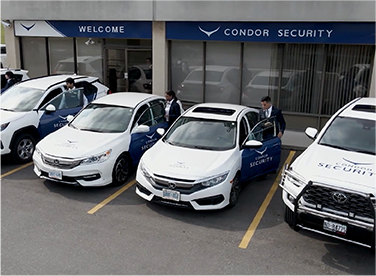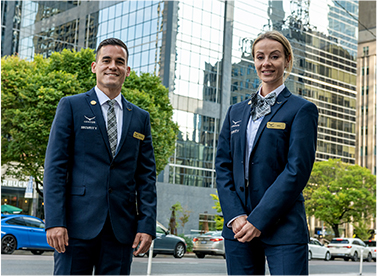SECURITY SYSTEMS DESIGN
INSTALLATION AND MAINTENANCE
Security Systems Design
Whether your immediate need is for a home security system or a more complex industrial security program, Condor Technologies employs qualified, licensed engineers and technicians who will implement a full solution professional security system from the ground up.
After meeting with you to gain a thorough understanding of your unique requirements, Condor’s highly experienced team will develop documents and blueprints that map out how to install your system to your exact specifications. Do you require a CCTV system for your property? Our team of tech experts will provide you with peace of mind from consultation and proposal to finished installation. Our tech team will advise you on the best camera equipment available, explain the features and benefits of the models available, and provide you with cost-effective pricing.

Integrated Security Systems Designs are well-integrated into enterprise security system environments. They are versatile and can even be integrated into other systems too. Elements of any security system design include:
- Drawings: Illustrates the concepts of a designer about the way a system is related to the building. It also offers details about the relationship of devices to the physical environment, conduit system, single-line diagrams, programming schedules, etc.
- Inter-discipline coordination: Each security system is unique and relates to more building systems than any other system of the building. They relate to door & gateway hardware, electrical, structural, parking, elevators, landscape, signage, automation systems, concrete, lighting, irrigation, and traffic control systems. inter-discipline coordination can make or break any installation.
- Specifications: Primarily the head of a security system, specifications include a description of the project, entire integrated system/subsystems, details of contractor services, acceptable products and installation, training, warranty, acceptance, and testing.
- Product Selection: When correct products are specified for a task, the system developed often exceeds the expectations of the owner himself. Wrong products can make an owner upset with the manufacturer, installer, and designer. Each project manager needs to provide a Bill of Quantities and take the approval of the designer beforehand.
- Client Management: It involves managing the relationship between your client and the firm you represent. Good client management ensures that a project is within its scope, schedule, and budget. Everything else has no relevance if one cannot keep track of these three important things related to the project. As a manager, you need to have an understanding of the decision-makers, influencers, and opinions.
- Project Management: A designer manages the design of a project and has to meet the expectations of the integrator, project manager, and the client. Designs are produced in four different phases namely, initiation, planning, execution, control, and completion of the project.
Condor Security Consulting and Security Systems Design
Condor Security Consulting has designed hundreds of integrated electronic security systems. Our focus has always been to deliver perfect solutions based on the specific needs of our clients. Each project came with its challenges and we have managed to learn mistakes that one often makes while designing such advanced system designs. These have helped us grow into a much better organization and our team is well-versed with the right approach when it comes to security system designing. Our focus has always been to minimize any such mistakes by focusing on the following key areas:
Designing In Response to Prevailing Crisis
Crisis such as death or major theft may make clients overreact and install a very high-end security system. Such systems might be designed to overkill the long-term security requirements of the client. As time passes, senior management starts thinking that they had installed excessive security measures at their facility. In the end, they tend to realize that their newly installed security systems were more of a trouble than being worth the requirements. Many companies end up discontinuing such systems. Hence, we evaluate the conditions and come up with the most logical design that not only takes care of the prevailing security crisis but is easy to maintain in the long run.
Designed without Support of Human Resources
Common in new construction projects, sophisticated integrated security systems are often designed for such new facilities. They need 24 hours of monitoring through control rooms, dedicated security offices, and an administrative level employee to manage the system. When implementing such a system, companies often ignore budgeting for the people who would eventually operate and manage.
Installing a security system means that the senior management is looking to reduce manpower and not increase it. In most cases, the company ends up having people who are not well-trained or knowledgeable to operate such advanced systems. Eventually, they become dissatisfied and stop using the system altogether. At our company, we pay importance to each aspect and integrate plans for both the execution and future operation of the systems we design. We believe it should be automated requiring minimal human intervention.
Designed With Limited Capacity
It’s often seen that a company integrates a security system that is designed to meet the immediate capacity needs of the company. For instance, they might be needing only 50 card readers and install an access control system with only 52 card reader capacity. Similarly, if they planned to install only 30 cameras, they would often opt for a network video recording having the capacity of 32 cameras. The moment their facility opens and they end up realizing that they might need another 10 cameras or 6 additional card readers.
In such cases either they do not have an additional budget to replace the head-end access control system or the video surveillance equipment. They might have to integrate a make-shift arrangement with duplicate equipment installed. Operations of such systems can be confusing and complicated in the long run. Hence, we do a comprehensive analysis before designing the project and make provisions for the maximum need that may increase with the company beginning or expanding its operations.
Designed With Excess Capacity
Access control systems designed for headquarters of major companies may immediately need 30 card readers. The security manager might estimate that in the future they might want corporate headquarter systems for controlling card readers at their 100 other branch offices. However, it is might be an estimate with no immediate plans or budget. But with just an estimated requirement that may or may not arise in the future, the manager might order a top-of-the-line enterprise system instead of a medium-sized system. Such systems with over 1000 card readers and 30 client workstations could cost over $90,000 for installing and are much more complicated.
Maintenance cost and software support or upgrades for such systems would also be much higher than needed. As time passes and manufacture announces that it would discontinue support because they are moving to a new software platform. Most importantly, the system is never expanded beyond the immediate capacity with then has to be replaced with a smaller and less expensive system. For avoiding such situations, we recommend doing a detailed analysis of the current, near-future, and long-term planning of the company. It’s better to install a security system that is scalable in the future than to invest in a big system that may or may not be used in the future.
Designing Less Complicated Systems
Installing a sophisticated security system integrated with intercom, CCTV, alarm monitoring, access control sounds great. A consultant also elaborates about everything related to the system and how to manage it. But in practice, users find it difficult to familiarize themselves with the system and never understand the intentions of the consultant. Hence the system and equipment installed are often underutilized and users end up wondering what the purpose was of the entire equipment installed.
We understand such situations and believe it’s not worth investing in a security system that you cannot use to the fullest. Our designs are intended to be easy to operate and maintain with minimal interventions from the user himself. After all, you cannot undergo full detailed training to operate a system and devote excessive time to it.
Security System Designs have gone through various transitions over the last few decades. With consistent efforts from experts, they come in much robust yet simpler designs that are easy to understand and managed in day-to-day operations. Our consultants will guide you and ensure you don’t have to be an engineer to understand how a systems works or is managed.
Whether your immediate need is for a home security system or a more complex industrial security program, Condor Technologies employs qualified, licensed engineers and technicians who will implement a full solution professional security system from the ground up.
OUR BLOG

Condor Technologies : Remote Video Monitoring in Toronto, Canada
Physical security protects people, properties and assets. A professional security services provider should offer top-level protection for all of the above

Integrating Innovative Technology with Physical Security
Physical security protects people, properties and assets. A professional security services provider should offer top-level protection for all of the above

Why You Need a Full-Service Security Company
The security services industry has always been at the forefront of new technology as well as being early adopters of trends